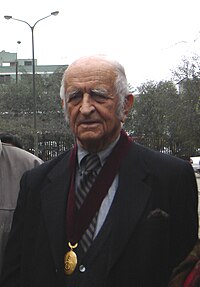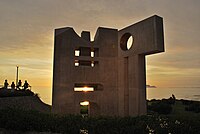| This article includes a list of general references, but it lacks sufficient corresponding inline citations. Please help to improve this article by introducing more precise citations. (May 2019) (Learn how and when to remove this message) |
In this Spanish name, the first or paternal surname is Szyszlo and the second or maternal family name is Valdelomar.
| Fernando de Szyszlo | |
|---|---|
 Fernando de Szyszlo in 2009 Fernando de Szyszlo in 2009 | |
| Born | Fernando de Szyszlo Valdelomar (1925-07-05)5 July 1925 Lima, Peru |
| Died | 9 October 2017(2017-10-09) (aged 92) Lima, Peru |
| Education | National University of Engineering Pontifical Catholic University of Peru |
| Known for | Painting, sculpture, printmaking |
| Movement | Abstract art, Surrealism, Informalism |
| Awards | Order of the Sun of Peru, 2011 |
Fernando de Szyszlo Valdelomar (5 July 1925 – 9 October 2017) was a Peruvian painter, sculptor, printmaker and teacher. He was a key figure in advancing abstract art in Latin America since the mid-1950s, and one of the leading plastic artists in Peru.
Life and career
Szyszlo was born in Lima, Peru; his mother was a Peruvian citizen of Mestizo ethnicity, and his father was a geographer from Poland. In 1943, Szyszlo entered the architecture school of Peru's National University of Engineering, but abandoned plans to follow that profession and enrolled in the school of plastic arts of the Pontifical Catholic University of Peru. After his graduation in 1948, he traveled to Europe where he studied the works of the masters, particularly Rembrandt, Titian and Tintoretto, and absorbed the varied influences of Cubism, Surrealism, Informalism, and abstraction. Szyszlo lived in Paris and Florence from 1948 to 1955, and then returned to Peru. While in Paris he met Octavio Paz and André Breton and was part of the group of expatriate Latin American artists and writers who met regularly at the Café de Flore, engaging in vigorous discussions on how they could participate in the international modern movement while preserving their Latin American cultural identity. Upon his return to Peru, Szyszlo became a major force for artistic renewal in his country breaking new ground by expressing a Peruvian subject matter in a non-representational style. In 1962, he became a professor of art at Cornell University. In 1965 he became a visiting lecturer at Yale University.
Personal life
Szyszlo was married to the Peruvian poet Blanca Varela (1926–2009), with whom he had two children. Their second son, Juan Lorenzo, a dual American-Peruvian citizen, was killed in the crash of Faucett Perú Flight 251, near Arequipa on February 29, 1996, aged 36, when he was heading to the city to oversee an exhibition of his father's work there.
Szyszlo died on 9 October 2017, the same day as his second wife, Lila Yábar (m. 1988) in a domestic accident according to his secretary. At the time of his death, he resided and worked in Lima.
Work

His work is represented in public and private collections throughout the world, including the Museum of Modern Art, New York; Solomon R. Guggenheim Museum, New York; Anita Shapolsky Gallery, New York; Museum of Fine Arts, Houston; Art Museum of the Americas, Washington, D.C.; Museo de Arte de Lima (Peru); Museu de Arte Moderna, São Paulo, Brazil; Museo Nacional de Arte, La Paz, Bolivia; Museo de Arte Contemporaneo Arequipa (Peru); and the Museum of Latin American Art, Long Beach, California, among others.
References
- Lyman, Eric J. (2 March 1996). "Search For Bodies From Peruvian Plane Crash Continues". Associated Press. Retrieved 29 May 2023.
- "Fernando de Szyszlo 1925, PE". ArtFacts.net.
External links
- Fernando de Szyszlo on Artnet
- Fernando de Szyszlo, represented by Latin American Masters
- Fernando de Szyszlo at MLA Gallery, Los Angeles Archived 27 April 2014 at the Wayback Machine
- Fernando de Szyszlo at Anita Shapolsky Gallery, New York
- Fernando de Szyszlo at Mixografia, Los Angeles Archived 3 March 2016 at the Wayback Machine